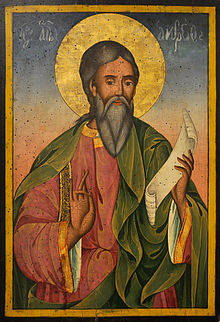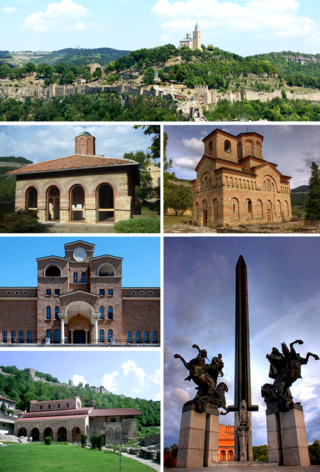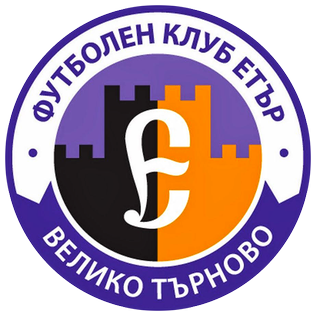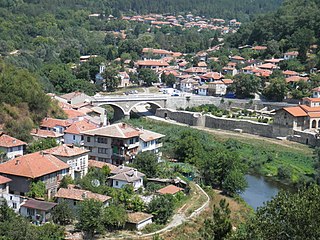







The culture of Veliko Tarnovo concerns the arts, museums, festivals and other entertainment in Veliko Tarnovo, Bulgaria.








The culture of Veliko Tarnovo concerns the arts, museums, festivals and other entertainment in Veliko Tarnovo, Bulgaria.
In medieval Turnovo (Tarnovgrad), Orthodox church music and medieval Bulgarian folklore were the basis of the Bulgarian culture. [1] The first piano in Bulgaria was imported into the city in the beginning of XVII century. A brass band was created in 1967. Boris Shopov is one of the founders and longtime teachers of the Children's Music School in Veliko Tarnovo.
There is scarce information about church and secular literature and poetry in Old Bulgarian. The most striking trace in the Medieval literature is left by the writers:Theodosius of Tarnovo, Methodius Svetogorets, Stefan Svetogorets, Konstantin Kostenechki, Gregory Tsamblak, Dimitar Kantakuzin, Tsani Ginchev. With dozens of novels, poetry and short stories, the creators Petko Slaveykov, Emiliyan Stanev, Assen Razcvetnikov stay in the history of the modern Bulgarian literature.
The creators of the Art School of Tarnovo leave the brightest trace of Bulgarian medieval creativity. Thousands of churches and monasteries were drawn from these figures throughout the Balkan Peninsula. Prominent Renaissance artists: Boris Denev. Contemporary Artists Nikola Donchev Totev – founder of the company of Turnovo artists, Angel Karaneshev, Ivan Valchanov, Asen Momchev, Angel Angelov, Blagoi Ivanov, Velio Mitev, Georgi Kostov, Krasimir Dobrev – Doctors, Margarita Pueva, Velio Mite, h. x. Jordan Popov, Nestor Ivanov, Denio Chokanov.
The first movie in the city was screened by Slovakian Yuri Kuzmich, who installed a cinema at Haralambi Penkov's store. In 1912, a modern theater cinema was built in the city in the place of Dryanovski inn. Until then, screenings will be held in the hall of the Chitalishte "Hope". The first tourist movie is being screened in the city. In 1945, a movie theater was built at the Iskra Culture Center. In 1974, the Poltava Cinema building was built, which remains emblematic of the city. The cinema hall discontinued its operations in 2010 and was destroyed in 2019
During the period of the Second Bulgarian Kingdom, the clothing of the rulers consisted of the following elements: dalmatia / divtation, loros, purple, zohus. Acacia, crown and scepter are added to them. The fabric of the royal family's and boyars' clothes was made of silk, linen and cotton. According to different color sources, they were mostly red or purple. Often the aristocratic costumes in the Second Bulgarian Kingdom are studded with pearls, precious stones and embroidered with gold brimstone. The clothes of other classes, whether of hemp, wool or leather. During the Renaissance, only the most wealthy and power-minded Turnovans were dressed in clothes influenced by Western Europe. After the Liberation of Bulgaria from Ottoman slavery, the European culture of clothing entered the city. The first fashion show took place in the city, it was the work of Evdokia Antonova, daughter of Anton Zarkov Zlatev, a well-known merchant of fabrics, money-lender and chiflikchia. In the streets, under lit streetlights, on aristocratic streets, citizens with rags and bombs and their wives with long dresses, crinolines, ruffles – wavy / corrugated / ornaments as well as wide, rich Buffon decorations were increasingly visible. Turnovo tailors in the beginning of the XX century, were known all over Northern Bulgaria. They were well aware of the tailoring in Italy and France.
The traditional women's Tarnovo costume consisted of: a hairpiece – mostly white (in some cases with red patterns), a white shirt with red or red-green patterns around the sleeves, a black dress, a black apron with several alternating rows of patterns: green, yellow, red, slippers – silver or gilded, pendants. Men were most often in white shirts, with red cuts and trousers.
The Regional Museum of History (Veliko Turnovo) has been in existence since 1879, with its original exposition being presented at the Chitalishte "Nadezhda". It is a find from antiquity and the Middle Ages. Since 1954, the museum has expanded significantly after changing its location several times. By the early 1960s, 16,000 archeological units were being stored in the museum.

Veliko Tarnovo is a city in north central Bulgaria and the administrative centre of Veliko Tarnovo Province. It is the historical and cultural capital of Bulgaria.

FC Etar Veliko Tarnovo is a former Bulgarian professional football club based in Veliko Tarnovo. They were last competing in the 2012–13 season of the Bulgarian A Professional Football Group, the top tier of professional football in Bulgaria. The club replaced the old FC Etar, which won the Bulgarian championship in 1991.

Etar is a Bulgarian sports football club based in Veliko Tarnovo, that plays in the Second League, the second level of Bulgarian football.
The siege of Varna took place between 21 and 24 March 1201 at Varna, on the Bulgarian Black Sea coast between the Bulgarians and the Byzantines. The Bulgarians were victorious and captured the city.

The Church of Saint Demetrius of Thessaloniki is a medieval Bulgarian Orthodox church in the city of Veliko Tarnovo in central northern Bulgaria, the former capital of the Second Bulgarian Empire.

The Church of Saints Peter and Paul is a medieval Bulgarian Orthodox church in the city of Veliko Tarnovo in central northern Bulgaria, the former capital of the Second Bulgarian Empire. The 13th-century church lies at the foot of the Tsarevets hill's northern slopes and was reconstructed in 1981.

The Patriarchal Cathedral of the Holy Ascension of the Lord is a former Eastern Orthodox cathedral in the city of Veliko Tarnovo, in north central Bulgaria. Located on top of the fortified Tsarevets hill in the former capital of the Second Bulgarian Empire, the cathedral was the seat of the Bulgarian patriarch from its construction in the 11th–12th century to its destruction in 1393.
Mihaltsi, or Mihalci, is a village in Pavlikeni Municipality, Veliko Tarnovo Province, northern Bulgaria. It is located at a distance of 9 km from the town of Pavlikeni, and 24 km from the city of Veliko Tarnovo.

Highways in Bulgaria are dual carriageways, grade separated with controlled-access, designed for high speeds. In 2012, legislation amendments defined two types of highways: motorways and expressways. The main differences are that motorways have emergency lanes and the maximum allowed speed limit is 140 km/h (87 mph), while expressways do not and the speed limit is 120 km/h (75 mph). As of October 2022, a total of 845.3 kilometers of motorways are in service.
Samovodene is a village in Veliko Tarnovo Municipality, north-central Bulgaria.
Sveta gora is a hill in Tarnovgrad and was spiritual and literary center in the Second Bulgarian Empire.
The Veliko Tarnovo Province Football League is a Bulgarian league for men's association football clubs in Veliko Tarnovo Province.

Momina krepost also called Devingrad(Bulgarian: Девинград) is a medieval stronghold located on a hill with the same name in Veliko Tarnovo in northern Bulgaria. This hill was one from the three main hills when Medieval Tarnovgrad was the capital of the Second Bulgarian Empire.

The Library of Veliko Tarnovo is the third largest library in Bulgaria.

Asenov is a district and neighbourhood of Veliko Tarnovo, Bulgaria.

Veliko Tarnovo is a city in north central Bulgaria and the administrative centre of Veliko Tarnovo Province. It is also known as Turnovo, Tsarevgrad or Turnov, and is a city with over 7000 years of history.

Veliko Tarnovo is a town with a historical architectural heritage. Many of the landmark buildings and bridges were destroyed by the 1913 earthquake. The town has developed architecture from four historic periods.

Marino pole is a district and neighbourhood of Veliko Tarnovo, Bulgaria.
Zlatko Sofroniev Zhivkov is a Bulgarian politician. He has been the mayor of the Montana Municipality since 1999.

Ledenik is a village in Central North Bulgaria, in the Veliko Tarnovo Municipality, Veliko Tarnovo Province - near the municipal city of Veliko Tarnovo. South of the village passes the river Yantra. The name of the village comes from the fact that it was famous for its ice houses in the past.